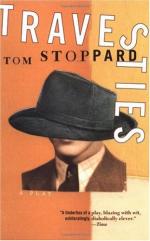|
This section contains 5,549 words (approx. 14 pages at 400 words per page) |

|
In the following essay, Meyer explores how Stoppard uses mtertextuality in Travesties to comment on writers, their art, and politics.
In Tom Stoppard's 1964 story, "Life, Tunes: Fragments," the writer-protagonist seeks originality by consciously denying the influence of previous writers: imagining himself a general on the field of battle, he surveys the corpses of the powerful precursors he has just vanquished. His first person accounts, however, are inevitably derivative, rilled with the haunting echoes of the very writers primarily Beckett and Hemingway he has supposedly killed off by the force of his own self-originary powers. "Artistic recyclying" dramatic allusion, mtertextuality, parody, travesty- -is not only inevitable, Stoppard is telling us, but necessary, it is only in the interweaving of texts the "convergences of different threads" as Stoppard called it that the new text emerges.
From the early Rosencrantz and Guildenstern Are Dead (1967) through Travesties (1975), Dogg 's Hamlet, Cahoot's...
|
This section contains 5,549 words (approx. 14 pages at 400 words per page) |

|




